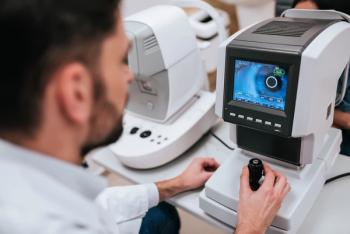
Current management and prevention of vitreoretinal complications of high myopia
The prevailing message is that physicians have “a long way to go” in the optimization of management and prevention of myopic vitreoretinal disease.
Cassie A. Ludwig, MD, MSc, Assistant Professor of Ophthalmology, Stanford University, Stanford, CA, addressed the epidemic of myopia and its vitreoretinal complications at the Envision Summit in Puerto Rico.
The prevailing message is that physicians have “a long way to go” in the optimization of management and prevention of myopic vitreoretinal disease.
Rhegmatogenous retinal detachment (RRD), myopic macular degeneration (MMD), and myopic traction maculopathy (MTM) are serious vision-threatening consequences of myopia. The prevalence rate of each of these 3 sequelae increases with increasing degrees of myopia.1
MMD is one of the most common causes of blindness worldwide. The META-analysis for Pathologic Myopia (META-PM) Study Group developed a classification and grading system ranging from 1 to 4 for MMD2 as follows: 1, tessellated fundus; 2-1, peripapillary diffuse chorioretinal atrophy; 2-2, macular diffuse chorioretinal atrophy; 3, patchy atrophy; and 4, patchy-atrophy related macular atrophy and choroidal neovascularization-related macular atrophy.
Patient management and monitoring
Myopic macular neovascularization (MNV) is fortunately quite responsive to anti-vascular endothelial growth factor (VEGF) therapy, requiring fewer injections than, for example, MNV related to age-related macular degeneration. For MTM, patients can be observed until they become symptomatic, at which point pars plana vitrectomy may be considered, possibly in addition to macular buckling in eyes in which the axial length is over 30 mm.3
Patients with posterior staphyloma at high risk for MMD and MTM should be monitored every 3 to 6 months. Patients with high axial lengths should be evaluated at least annually with a scleral depressed examination.
Prevention
Some proactive steps are possible.
For those at risk of MMD, patients are advised to stop smoking, eat green leafy vegetables, and self-monitor using an Amsler grid. Patients should present urgently with any vision changes noted on Amsler grid testing for evaluation and consideration of anti-VEGF therapy.
To prevent MTM and MMD, Ludwig commented that the focus on myopia prevention starts in childhood and that, “every diopter matters.”4 The axial length of myopic children should be monitored for progression and physicians should consider treating patients who progress rapidly. Studies are underway to determine the benefits of treating pre-myopes. Co-management of patients with optometrists is recommended.
For patients with RRDs, prophylactic laser should be performed on all high-risk peripheral pathology in the contralateral eye prior to or at the time of surgery on the detached retina to prevent bilateral detachments.
“With careful attention to these complex eyes, we can treat and prevent many sequelae but we still have a long way to go to fully halt the potentially devastating effects of axial elongation on the vitreous, retina, and choroid,” Ludwig concluded.
References:
Haarman AEG, Enthoven CA, Tideman JWL, et al. The complications of myopia: a review and meta-analysis. Invest Ophthalmol Vis Sci. 2020;61:49.
Ohno-Matsui K, Kawasaki R, Jonas JB, et al; META-analysis for Pathologic Myopia (META-PM) Study Group. International photographic classification and grading system for myopic maculopathy. Am J Ophthalmol. 2015;159:877-83.e7. doi: 10.1016/j.ajo.2015.01.022. Epub 2015 Jan 26.
Clark A, Souverein EA, Rootman DB, et al. Macular sling: a customizable method for macular buckling using available elements. Retin Cases Brief Rep. 2023 May 22; Epub ahead of print.
Bullimore MA, Brennan NA. Myopia control: why each diopter matters. Optom Vis Sci. 2019;96:463-465.
Newsletter
Want more insights like this? Subscribe to Optometry Times and get clinical pearls and practice tips delivered straight to your inbox.








































